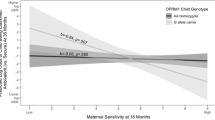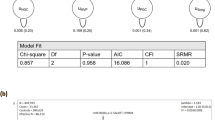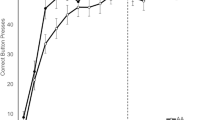Abstract
Variation in the μ-opioid receptor gene has been associated with early social behavior in mice and rhesus macaques. The current study tested whether the functional OPRM1 A118G predicted various indices of social relations in children. The sample included 226 subjects of self-reported European ancestry (44% female; mean age 13.6, SD=2.2) who were part of a larger representative study of children aged 9–17 years in rural North Carolina. Multiple aspects of recent (past 3 months) parent–child relationship were assessed using the Child and Adolescent Psychiatric Assessment. Parent problems were coded based upon a lifetime history of mental health problems, substance abuse, or criminality. Child genotype interacted with parent behavior such that there were no genotype differences for those with low levels of parent problems; however, when a history of parent problems was reported, the G allele carriers had more enjoyment of parent–child interactions (mean ratio (MR)=3.5, 95% CI=1.6, 8.0) and fewer arguments (MR=3.1, 95% CI=1.1, 8.9). These findings suggest a role for the OPRM1 gene in the genetic architecture of social relations in humans. In summary, a variant in the μ-opioid receptor gene (118G) was associated with improved parent–child relations, but only in the context of a significant disruption in parental functioning.
Similar content being viewed by others
Log in or create a free account to read this content
Gain free access to this article, as well as selected content from this journal and more on nature.com
or
References
American Psychiatric Association (1994). Diagnostic and Statistical Manual of Mental Disorders Fourth Edition (DSM-IV). American Psychiatric Press: Washington, DC.
Angold A, Costello EJ (1995). A test-retest reliability study of child-reported psychiatric symptoms and diagnoses using the Child and Adolescent Psychiatric Assessment (CAPA-C). Psychol Med 25: 755–762.
Angold A, Costello E (2000). The Child and Adolescent Psychiatric Assessment (CAPA). J Am Acad Child Adolesc Psychiatry 39: 39–48.
Angold A, Erkanli A, Farmer E, Fairbank J, Burns B, Keeler G et al (2002). Psychiatric disorder, impairment, and service use in rural African American and white youth. Arch Gen Psychiatry 59: 893–901.
Arias A, Feinn R, Kranzler HR (2006). Association of an Asn40Asp (A118G) polymorphism in the [mu]-opioid receptor gene with substance dependence: a meta-analysis. Drug Alcohol Depend 83: 262–268.
Barr C, Schwandt M, Lindell BS, Chen SA, Goldman D, Suomi SJ et al (2007). Association of a functional polymorphism in the mu-opioid receptor gene (OPRM1C77G) with alcohol response and consumption in male rhesus macaques. Arch Gen Psychiatry 64: 369–376.
Barr C, Schwandt M, Lindell BS, Higley JD, Maestripieri D, Goldman D et al (2008). Variation in the mu-opioid receptor gene (OPRM1) influences attachment behavior in infant primates. Proc Natl Acad Sci USA 105: 5277–5281.
Bart G, LaForge K, Borg L, Lilly C, Ho A, Kreek M (2006). Altered levels of basal cortisol in healthy subjects with a 118G allele in exon 1 of the mu opioid receptor gene. Neuropsychopharmacology 31: 2313–2317.
Befort K, Filliol D, Decaillot F, Gaveriaux-Ruff C, Hoehe M, Kieffer B (2001). A single nucleotide polymorphic mutations in the human mu-opioid receptor severely impairs receptor signaling. J Biol Chem 276: 3130–3137.
Beyer A, Koch T, Schroeder H, Schultz S, Hollt V (2004). Effect of the A118G polymorphism on binding affinity, potency, and agonist-medicated edocytosis, desensitization, and resensitization of the human mu-opioid receptor. J Neurochem 89: 553–560.
Bodnar RJ (2008). Endogenous opiates and behavior: 2007. Peptides 29: 2292–2375.
Bond C, LaForge K, Tian M, Melia D, Zhang S, Borg L et al (1998). Single-nucleotide polymorphism in the human mu opioid receptor gene alters beta-endorphin binding and activity: possible implications for opiate addiction. Proc Natl Acad Sci USA 95: 9608–9613.
Fillingim RB, Kaplan L, Staud R, Ness TJ, Glover TL, Campbell CM et al (2005). The A118G single nucleotide polymorphism of the [mu]-opioid receptor gene (OPRM1) is associated with pressure pain sensitivity in humans. JPain 6: 159–167.
Gibbs RA, Belmont JW, Hardenbol P, Willis TD, Yu F, Yang H et al (2003). The international HapMap project. Nature 426: 789–796.
Herman BH, Panksepp J (1978). Effects of morphine and naloxone on separation distress and approach attachment: evidence for opiate mediation of social affect. Pharmacol Biochem Behav 9: 213–220.
Ioannidis J (2006). Grading the credibility of molecular evidence for complex disease. Int J Epidemiol 35: 572–577.
Insel TR (1997). A neurobiological basis of social attachment. Am J Psychiatry 154: 726–735.
Jaffee SR, Belsky J, Harrington H, Caspi A, Moffitt TE (2006). When parents have a history of conduct disorder: how is the caregiving environment affected? J Abnorm Psychol 115: 309–319.
Kalin N, Shelton S, Barksdale C (1988). Opiate modulation of separation-induced distress in non-human primates. Brain Res 440: 285–292.
Kalin N, Shelton S, Lynn D (1995). Opiate systems in mother and infant primates coordinate intimate contact during reunion. Psychoneuroendocrinology 20: 735–742.
Kieffer BL, Evans CJ (2009). Opioid receptors: from binding sites to visible molecules in vivo. Neuropharmacology 56 (Suppl 1): 205–212.
Knowles PA, Conner RL, Panksepp J (1989). Opiate effects on social behavior of juvenile dogs as a function of social deprivation. Pharmacol Biochem Behav 33: 533–537.
Kreek MJ, LaForge KS (2007). Stress responsivity, addiction, and a functional variant of the human Mu-opioid receptor gene. Mol Interv 7: 74–78.
Kroslak T, LaForge K, Gianotti R, Ho A, Nielsen D, Kreek M (2007). The single nucleotide polymorphism A118G alters functional properties of the human mu opioid receptor. J Neurochem 103: 77–87.
Lieb R, Wittchen HU, Hofler M, Fuetsch M, Stein MB, Merikangas KR (2000). Parental psychopathology, parenting styles, and the risk of social phobia in offspring: a prospective-longitudinal community study. Arch Gen Psychiatry 57: 859–866.
Marcenko MO, Kemp SP, Larson NC (2000). Childhood experiences of abuse, later substance use, and parenting outcomes among low-income mothers. Am J Orthopsychiatry 70: 316–326.
Moles A, Kieffer B, D’Amato F (2004). Deficit in attachment behavior in mice lacking the mu-opioid receptor gene. Science 304: 1983–1986.
Nelson EE, Panksepp J (1998). Brain substrates of infant-mother attachment: contributions of opioids, oxytocin, and norepinephrine. Neurosci Biobehav Rev 22: 437–452.
Panksepp J, Herman B, Conner R, Bishop P, Scott J (1978). The biology of social attachments: opiates alleviate separation distress. Biol Psychiatry 13: 607–618.
Ray LA, Hutchison KE (2007). Effects of naltrexone on alcohol sensitivity and genetic moderators of medication response: a double-blind placebo-controlled study. Arch Gen Psychiatry 64: 1069–1077.
Ray WA (2005). Observational studies of drugs and mortality. N Engl J Med 353: 2319–2321.
SAS Institute Inc (2004). SAS/STAT® Software: Version 9. SAS Institute: Cary, NC.
Simmons D, Self D (2009). Role of mu- and delta-opioid receptors in the nucleus accumbens in cocain-seeking behavior. Neuropsychopharmacology 34: 1946–1957.
Spanagel R, Herz A, Shippenberg T (1992). Opposing tonically active endogenous opioid systems modulate the mesolimbic dopaminergic pathway. Proc Natl Acad Sci USA 89: 2046–2050.
Sullivan PF, Eaves LJ, Kendler KS, Neale MC (2001). Genetic case-control association studies in neuropsychiatry. Arch Gen Psychiatry 58: 1015–1024.
Wand GS, McCaul M, Yang X, Reynolds J, Gotjen D, Lee S et al (2002). The mu-opioid receptor gene polymorphism (A118G) alters HPA axis activation induced by opioid receptor blockade. Neuropsychopharmacology 26: 106–114.
Way BM, Taylor SE, Eisenberger NI (2009). Variation in the mu-opioid receptor gene (OPRM1) is associated with dispositional and neural sensitivity to social rejection. Proc Natl Acad Sci USA 106: 15079–15084.
Acknowledgements
The work was supported by the National Institute on Alcohol Abuse and Alcoholism Intramural Research Program, the National Institute of Drug Abuse (DA024413 to EJC), and the National Institute for Mental Health (MH080230 to WEC).
Author information
Authors and Affiliations
Corresponding author
Ethics declarations
Competing interests
The authors declare no conflict of interest.
Rights and permissions
About this article
Cite this article
Copeland, W., Sun, H., Costello, E. et al. Child μ-Opioid Receptor Gene Variant Influences Parent–Child Relations. Neuropsychopharmacol 36, 1165–1170 (2011). https://doi.org/10.1038/npp.2010.251
Received:
Revised:
Accepted:
Published:
Issue date:
DOI: https://doi.org/10.1038/npp.2010.251
Keywords
This article is cited by
-
Variation in the mu-opioid receptor gene (OPRM1) moderates the influence of maternal sensitivity on child attachment
Translational Psychiatry (2024)
-
Mu opioid receptor gene (OPRM1) moderates the influence of perceived parental attention on social support seeking
Adaptive Human Behavior and Physiology (2022)
-
Attenuation of antidepressant and antisuicidal effects of ketamine by opioid receptor antagonism
Molecular Psychiatry (2019)
-
Touch-induced face conditioning is mediated by genetic variation in opioid but not oxytocin receptors
Scientific Reports (2018)
-
Time to connect: bringing social context into addiction neuroscience
Nature Reviews Neuroscience (2016)



